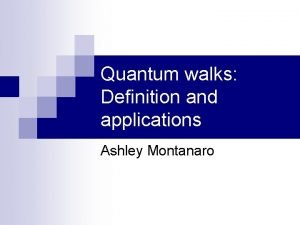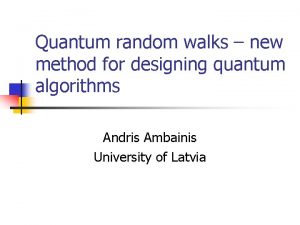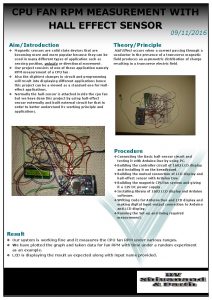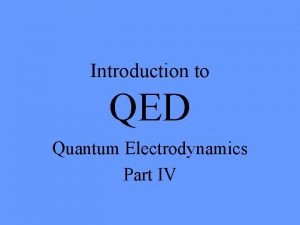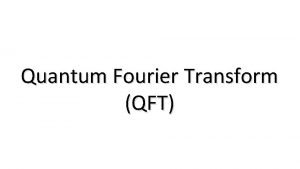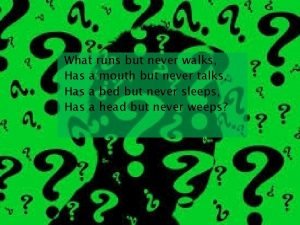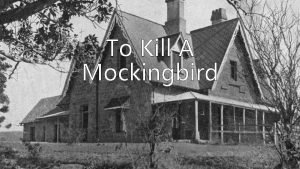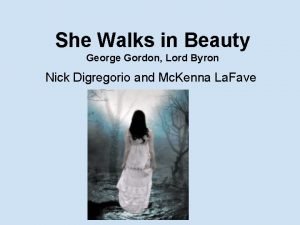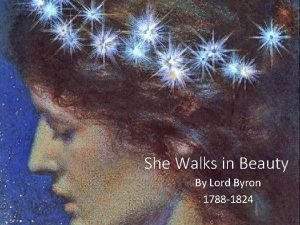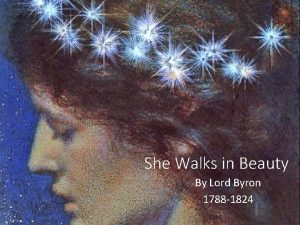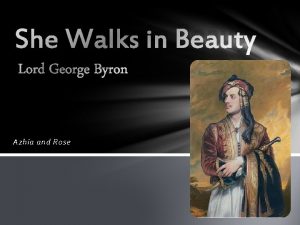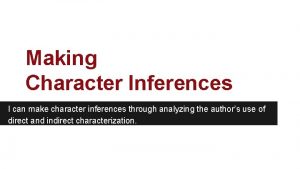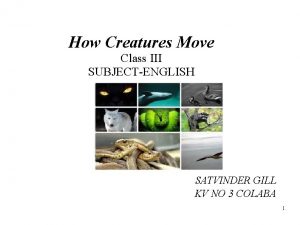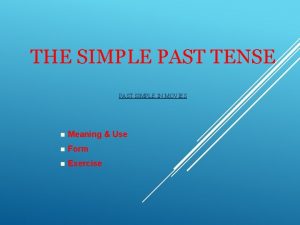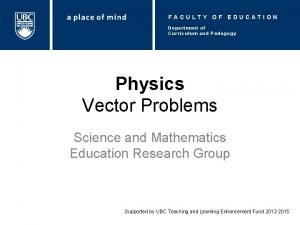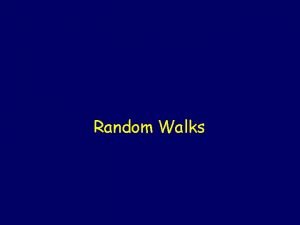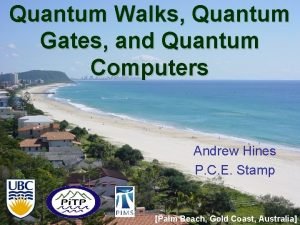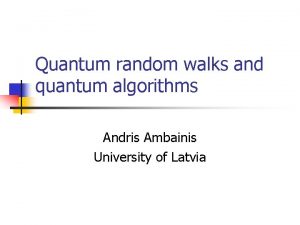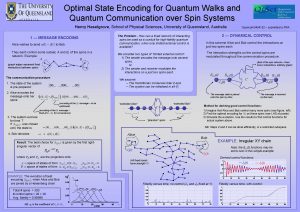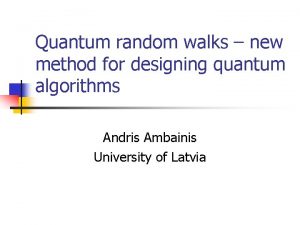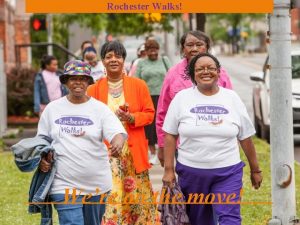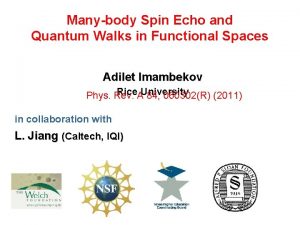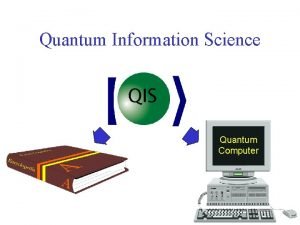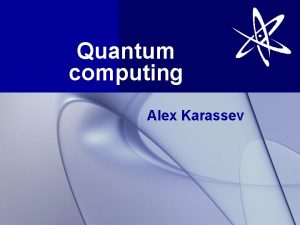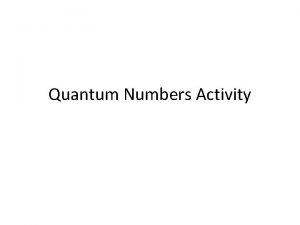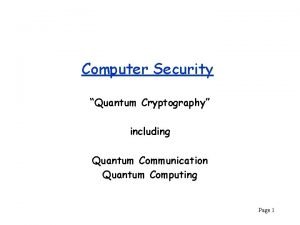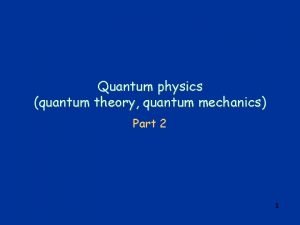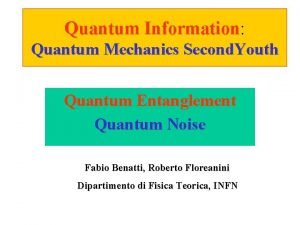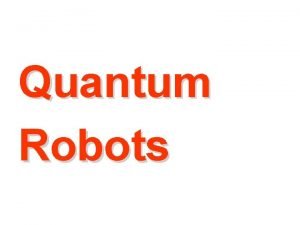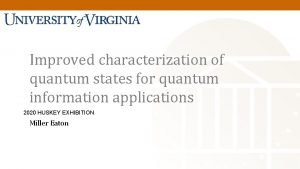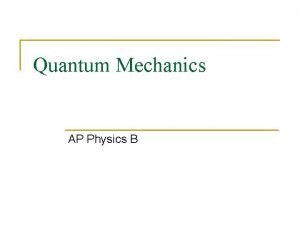Quantum walks Definition and applications Ashley Montanaro Talk




























- Slides: 28

Quantum walks: Definition and applications Ashley Montanaro

Talk structure n Introduction to quantum walks n Defining a quantum walk ¨. . . on the line ¨. . . on undirected graphs NEW ¨. . . on directed graphs n Applications of quantum walks

What are quantum walks? n A random walk is the simulation of the random movement of a particle around a graph n A quantum walk is the same – but with a quantum particle ¨ n not the same as running a normal random walk algorithm on a quantum computer Random walks are a useful model for developing classical algorithms; quantum walks provide a new way of developing quantum algorithms ¨ which is particularly important because producing new quantum algorithms is so hard

Physical intuition behind a classical random walk on a graph Time 5 2 1 n 4 3 6 0 1 2 3 Probability at vertex 1 2 3 4 5 6 1 ½½ 1 After 3 steps we are in position “ 5” or “ 6” with equal probability. ½½

Physical intuition behind a quantum walk on a graph Light detectors Mirror 5 2 6 4 1 3 Half-silvered mirror

Physical intuition behind a quantum walk on a graph Time 5 2 6 4 1 3 n 0 1 2 3 Amplitude at point 1 2 3 4 5 6 1 After 3 steps we are guaranteed to be in detector “ 6” – this is caused by quantum interference. 1

Mathematical definition of a random walk n Express a classical random walk as a matrix W of transition probabilities ¨ n 2 4 1 3 where the entries in each column sum to 1 Express a position as a column vector v n Performing a step of the walk corresponds to pre-multiplying v by W n Performing n steps of the walk corresponds to pre-multiplying v by Wn =

Mathematical definition of a quantum walk n Very similar, but: probabilities combine differently (sum of the amplitudes squared must be 1) ¨ the transition matrix must be unitary (ie. send unit vectors to unit vectors) ¨ n n This will not in general be the case, so we may need to modify the structure of the graph – for example, by adding a coin space This can be considered as a quantum analogue of flipping a coin to decide which direction to go at each step of the walk 2 4 1 3 = (e. g. )

Classical random walk on the line n Consider a walk on the following simple infinite graph: n Versions of this walk are useful models for many random processes n When the walker has equal probability to move left or right, it’s well-known that the average distance from the start position after time n is sqrt(n) n But we can define a quantum walk on the same graph with different behaviour: an average distance of n

Quantum walk on the line n We have two quantum registers: a coin register holding |L or |R , and a position register |p n Our walk operation is a coin flip followed by a shift n ¨ coin flip: send ¨ shift: send |L + i|R , |R i|L + |R |L |p-1 |R |p+1 These are both unitary operations, and hence their combination is too so, together, they provide a way of defining a quantum walk on the line ¨ there are other ways – e. g. the continuous-time formulation of quantum walks ¨

A few iterations of the walk on the line 1. start |R |0 2. coin (i|L + |R )|0 shift i|L |-1 + |R |1 3. coin (i|L - |R )|-1 + (i|L + |R )|1 shift i|L |-2 - |R |0 + i|L |0 + |R |2 4. coin (i|L - |R )|-2 + (i|L + |R )|2 shift i|L |-3 - |R |-1 + i|L |1 + |R |3 Equal probability to be at |-3 , |-1 , |1 or |3 - whereas classical random walk favours |-1 , |1

Classical vs. quantum walk on the line Running a classical walk on the line results in a probability distribution like: position Whereas running this quantum walk for the same number of steps gives: The peaks and troughs in this graph are caused by quantum interference.

Quantum walks on undirected graphs n Consider a d-regular graph G (each vertex has d arcs leaving it) n We can label each arc and choose between them using a d-dimensional “coin” ¨ A variety of coin operators can be used: we usually pick one to mix between all arcs equally n As before, one step of the walk consists of a coin flip followed by a shift n An irregular graph can be handled using a different coin for each vertex of a different degree ¨ or other methods. . .

Behaviour of quantum walks on undirected graphs n We can define quantum equivalents of the mixing time and hitting time of a walk n The mixing time of a random walk is the time it takes to converge to a limiting distribution ¨ n Quantum walks have quadratically faster mixing time for any undirected graph The hitting time is the time it takes to reach a given vertex On certain graphs, quantum walks have exponentially faster hitting time ¨ Open question: for which graphs is this true? ¨

NEW Quantum walks on directed graphs n A quantum walk can be defined on any undirected graph, with the use of a suitable coin n But it turns out that not all directed graphs support the idea of a quantum walk: only reversible ones do a reversible graph is a graph where, if you can get from a to b, you can get from b to a ¨ each component of such graphs is strongly connected ¨ compare the idea that quantum computers have to be reversible ¨ n Quantum walks defined on irreversible graphs will not respect the structure of the graph: there will be some possibility to traverse arcs in the “wrong direction”

NEW Reversible and irreversible graphs n These graphs are reversible: n These graphs are irreversible:

Implications for translation of classical algorithms n NEW Many classical algorithms can be represented as a random walk on a directed graphs with sinks – the idea is to find a sink, which represents a solution to a problem ¨ e. g. Schöning’s random walk algorithm for SAT n A quantum walk cannot be defined on these graphs; this suggests that there is no easy translation of these algorithms into a quantum walk form n However, it is possible to produce a quantum walk which is “like” the original random walk in the sense that, after a long period of time, it has a high probability of ending up in a sink

Applications of quantum walks n Quantum network routing ¨ n Quantum walk search algorithm ¨ n Shenvi, Kempe, Whaley, 2002 Element distinctness ¨ n Kempe, 2002 Ambainis, 2004 Applications of element distinctness Magniez, Santha, Szegedy, 2003 ¨ Buhrmann, Spalek, 2004 ¨

Quantum network routing n Consider a network whose topology is a d-dimensional hypercube n We want to route a packet from one corner of the hypercube to the other (eg. from 000 to 111) 010 111 011 100 000 101 001 n Algorithm: perform ~d steps of a quantum walk. Then measure to see where the packet is. n This has advantages over a classical routing algorithm: it’s noise resistant: deleting intermediate links will not affect the walk much ¨ intermediate nodes need minimal routing “hardware” ¨

Quantum walk search algorithm n Consider the unstructured search problem: given a function f(x) = { 1 if x = a, 0 otherwise } find the “marked” element a, where 0 a 2 n-1. n Grover’s algorithm can solve this in O(2 n/2) queries on a quantum computer, whereas a classical computer needs at least W(2 n) queries n Can we produce a quantum walk algorithm that requires the same (optimal) number of queries? ¨ this may be easier to implement, or provide a better model for searching a “real” database

Quantum walk search algorithm (2) n We perform a quantum walk on the hypercube of dimension n each vertex, labelled by an n-bit string, corresponds to a possible input to the oracle ¨ each vertex has n neighbours ¨ n Our walk consists of a combination of a coin flip and a shift, as before ¨ n Identify each of the n coin states with each neighbour of a vertex Use a “marking” coin operator ¨ ¨ When at an unmarked vertex, pick a coin state randomly When at the marked vertex, stay in the same coin state

Quantum walk search algorithm (3) n Start with a superposition over all vertices n If we run the walk for O(2 n/2) steps, can prove that there is a high probability it will “home in” on the marked vertex ¨ in fact, there’s a general result stating that “perturbed” walks like this will always find one of the marked elements n We then simply measure the position and we’ve found the marked item

Element distinctness n Problem: does a (multi-)set S of N elements contain any duplicate elements? n Call reading an element from the set a query n Clearly, classically we need N queries to answer the question with certainty n It turns out that a quantum walk algorithm can solve the problem in O(N 2/3) queries ¨ which has been proven to be optimal

Quantum walk algorithm for element distinctness n We use a quantum walk on a graph where the vertices are subsets of S containing either M or M + 1 elements for some M < N {1, 1, 2, 3} 11, 12, 2 11, 2 n n Two vertices are connected if they differ in exactly one element The graph on the right encodes the set {1, 1, 2, 3} for M = 2 11, 3 12, 2 12, 3 11, 2, 3 12, 2, 3

Quantum walk algorithm for element distinctness (2) n Basic walk algorithm: start with some subset S’ S (where |S’| = M) 2. check whether S’ contains any duplicates (needs O(M) queries) 3. if not, change to a different subset S’’ that differs in exactly one element 4. check S’’ for duplicates (needs 1 query) 5. repeat steps 3 and 4 until a duplicate is found 1. n Because this is a quantum walk, we can start with a superposition of all M-subsets

Analysis of quantum walk n In total, we need (M + r) queries, where M is the number of elements in the initial subset ¨ r is the number of steps of the quantum walk ¨ n It turns out that if we pick M = N 2/3, then a solution can be found with high probability in r = N 1/3 steps of the walk resulting in O(N 2/3) queries in total ¨ it also turns out that the number of non-query operations required is small, so the query complexity is a good measure of the time complexity ¨ n Note that this algorithm requires a significant amount of space – enough to store O(N 2/3) elements

Applications of element distinctness n Using element distinctness as a subroutine, quantum walk algorithms have been developed to solve other problems: ¨ finding a triangle in a graph with n vertices in time O(n 1. 3) ¨ verifying matrix multiplication (testing if A*B = C for some n*n matrices A, B, C) in time O(n 1. 67) n The algorithm has also been generalised to solve the problem of finding any subset that has a given property find (a, b) such that (f(a), f(b)) P, where P is some property ¨ i. e. :

Conclusions and further reading n Quantum walks can be defined on any undirected graph, and on reversible directed graphs. n Quantum walks are a way to develop quantum algorithms that outperform their classical counterparts. n Further reading (on www. arxiv. org): “Quantum walks and their algorithmic applications”, A. Ambainis, quant-ph/0311001 ¨ “Quantum random walks – an introductory overview”, J. Kempe, quant-ph/0303081 ¨ “Quantum walks on directed graphs”, A. Montanaro, quantph/0504116 ¨
 Ashley montanaro
Ashley montanaro She who walks with integrity walks securely meaning
She who walks with integrity walks securely meaning Montanaro ematologo viterbo
Montanaro ematologo viterbo Quantum walks
Quantum walks Quantum walks
Quantum walks Classical mechanics
Classical mechanics Quantum physics vs quantum mechanics
Quantum physics vs quantum mechanics Talk read talk write template
Talk read talk write template Amateurs discuss tactics professionals discuss logistics
Amateurs discuss tactics professionals discuss logistics The words use are not
The words use are not Rpm hall effect sensor
Rpm hall effect sensor Quantum electrodynamics applications
Quantum electrodynamics applications Complex fourier transform
Complex fourier transform Magic bullet chop onions
Magic bullet chop onions What can run but never walks has a mouth
What can run but never walks has a mouth Jem walks scout to school
Jem walks scout to school She walks in beauty simile
She walks in beauty simile She walks in beauty summary
She walks in beauty summary Imagery in she walks in beauty
Imagery in she walks in beauty She walks in beauty imagery
She walks in beauty imagery She walks in beauty figurative language
She walks in beauty figurative language Character inferences
Character inferences Raghav has been staying in the society for 7 years
Raghav has been staying in the society for 7 years How creatures move worksheet
How creatures move worksheet Past tense of walks
Past tense of walks She walks in beauty annotations
She walks in beauty annotations Once upon a time there lived a little
Once upon a time there lived a little Steve walks from point p to point q
Steve walks from point p to point q The fly cup inverurie
The fly cup inverurie
